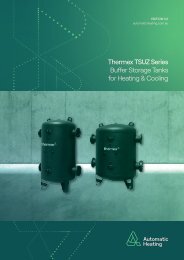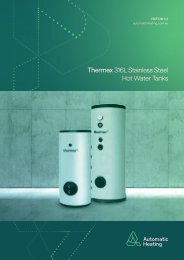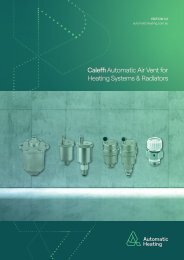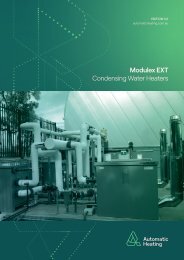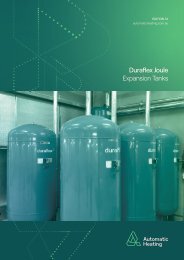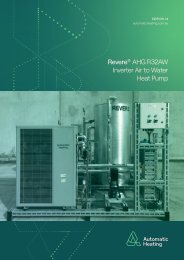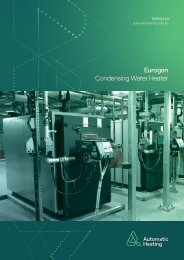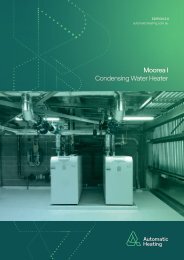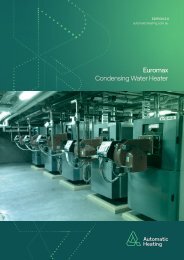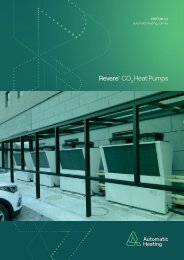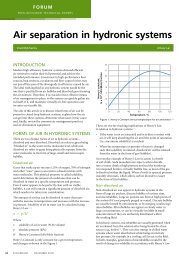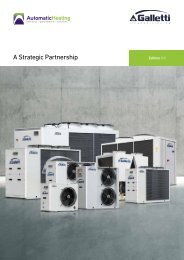AHG Solutions Guide_Edition 2.7
Full Product and Solutions Guide - Automatic Heating Global Pty Ltd
Full Product and Solutions Guide - Automatic Heating Global Pty Ltd
You also want an ePaper? Increase the reach of your titles
YUMPU automatically turns print PDFs into web optimized ePapers that Google loves.
Condensing Boilers<br />
Contents<br />
CONDENSING &<br />
CONVENTIONAL BOILERS<br />
Introduction to<br />
Condensing Boilers<br />
Condensing water heaters have been manufactured since the 1980s, and now<br />
represent a fully mature technology used extensively throughout the world.<br />
What is a Condensing Boiler?<br />
The condensing water heater is a system of technologies,<br />
consisting of the water heater itself fuelled by gas or<br />
oil, the flue stack, and the condensate collection system.<br />
Condensing water heaters operate at around 90-98% gross<br />
efficiency, compared with 80-85% gross efficiency for<br />
conventional water heaters.<br />
They achieve higher efficiencies by using newer technology<br />
and by condensing the water vapour that is produced during<br />
combustion and trapped in the flue gases.<br />
In traditional water heater technologies, the latent heat<br />
contained in the water vapour is allowed to escape through<br />
the flue. Condensing water heaters reclaim that latent heat<br />
by condensing the water vapour and transferring its heat<br />
to the return water via a secondary heat exchanger with a<br />
resultant increase in water heating efficiency.<br />
The flue stack temperature is considerably<br />
reduced and the return water temperature<br />
raised. Hence the term ‘Condensing Water<br />
Heater’.<br />
These potential efficiency gains are achieved if the water<br />
heater is operating in or near condensing mode, which<br />
requires the temperature of the water returning from the<br />
building to the water heater to be as low as possible. Having<br />
said that, condensing water heaters will achieve increased<br />
efficiencies over non-condensing water heaters even in<br />
a situation utilizing the existing building return water<br />
temperature, due to the larger surface area of the heat<br />
exchanger in a condensing water heater and the reduced<br />
flue temperature.<br />
Optimum return water temperatures are achieved when<br />
the return water is below the dew point of the water vapour<br />
in the flue gas. The dew point is determined by several<br />
variables, including altitude, outdoor air temperature, and<br />
the type of fuel the water heater consumes. The critical<br />
variable, however, is combustion efficiency: excess oxygen<br />
in the combustion process leads to lower efficiency and<br />
requires a lower dew point before condensation can<br />
begin. In general, with efficient combustion, return water<br />
temperatures (RWT) should be below 54°C, with lower RWT<br />
resulting in more condensation and greater efficiency.<br />
Condensing water heaters require Stainless Steel flues to<br />
prevent corrosion. The condensate produced is also slightly<br />
acidic so a condensate neutraliser is required before piping<br />
condensate to the drain. Plastic piping must be used for the<br />
condensate drain to prevent corrosion.<br />
Why is a condensing boiler “greener” than a<br />
non-condensing one?<br />
A condensing boiler makes better use of the heat that<br />
it generates from burning fuels such as gas or oil. In a<br />
conventional boiler some of this heat is wasted because<br />
the boiler releases very hot waste gases from its flue. A<br />
condensing boiler uses some of the heat from these waste<br />
gases to heat water returning from your central heating<br />
system, so it requires less heat from the burner. This makes<br />
your condensing boiler more efficient. The efficiency of a<br />
boiler is normally expressed as a percentage – some new<br />
condensing boilers can be up to 98% efficient compared to<br />
non-condensing ones that are around 80 to 83% efficient,<br />
and older boilers that are only 70% to 75% efficient.<br />
How does a condensing boiler reduce carbon<br />
dioxide emissions?<br />
BOILER EFFICIENCY %<br />
110<br />
100<br />
90<br />
GROSS EFFICIENCY<br />
NET EFFICIENCY<br />
80<br />
20 30 40 50 54 60 70 80<br />
RETURN WATER TEMPERATURE ºC<br />
Carbon dioxide savings come from burning less fuel to<br />
meet your heating needs. Imagine that one unit of fuel<br />
potentially contains enough energy to heat your home for<br />
an hour. Burning that fuel in a boiler that is 100% efficient<br />
would heat your home for an hour. Burning that unit of fuel<br />
in a boiler that is 90% efficient would only give you enough<br />
to heat your home for 54 minutes, and if it’s 75% efficient<br />
you’d only get 45 minutes per unit. So, the lower the<br />
efficiency of your boiler the more units of fuel you need to<br />
burn to keep your home at the right temperature. The more<br />
fuel you burn, the more carbon dioxide you emit.<br />
68



